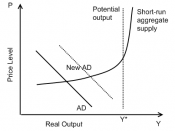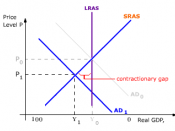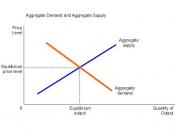THE EXTENDED AS-AD MODEL
In order to understand the effects of inflation in the long run, lets first analyze the long run aggregate demand (AD) and aggregate supply (AS) curves in the long run through the extended AS-AD model.
SHORT-RUN AND LONG-RUN AGGREGATE SUPPLY
Short Run
It is the period in which nominal wages (and other input prices) remain fixed as the price level increases or decreases.
Causes of fixed nominal wages:
* Workers may not immediatel y be aware of the extent that inflation or deflation has changed their real wages, and thus they may not adjust their labor supply decisions and wage demands accordingly.
* Many employees are hired under fixed-wage contracts. For unionized employees their prospective wages are set for 2 years. Other professionals too have annual contracts.
For the reasons mentioned above, price- level changes don't immediately give rise to changes in nominal wages in the short run.
The short period can also be explained with the help of a graph. In this graph, only the intermediate range of the AS curve has been considered. In the short run, nominal wages a re fixed and based on price level P1 and the expectation that it will continue. An increase in the price level from P1 to P2 increases profits and output moving the economy from a1 to a2; a decrease in the price level from P1 to P3 reduces profits and real output, moving the economy from a1 to a3. The short run aggregate supply curve therefore slopes upward.
Long Run
It is the period in which nominal wages are fully responsive to previous changes in the price level. Let us illustrate this by a graph. Suppose that the economy is initially at point a1 (P1 and QF). When the price level will increase from P1...


